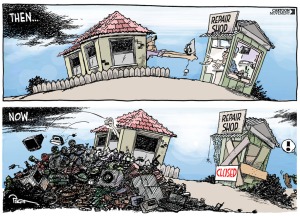Not only do we need to and aspire to consume, our status within a society is linked to these products. Yet, with the economy in turmoil, has the capitalist system exploited this ‘need’ too much in their quest for increasing profits? The products that we buy have shorter life spans, and even if they manage to stand the test of time, advertising targets us with newer, better products that encourage us to go on needless shopping sprees. So where did this needless consuming begin; and where was this ‘need’ created?
I think that change in culture started in the 1950’s. TV advertising was targeting the lovely housewife with convenient and disposable products to make their lives easier and more enjoyable. Take a look at the following headline from a 1959 Look Magazine article. “Why spend time cleaning pots and pans and dishes when you can toss it all away in the garbage when you’re done? The idea of disposability and the convenience, of both cost and access, to an increasing product range that gave the idea of abundance. It was this changing of mentality that led us up the ‘can never have enough’ path. For the A level sociology students out there, you can link this to the Modernisation Theories, and Walt Rostow’s stages of development in which ‘the age of mass consumption’ is the final stage.
Returning to the advertising, the marketing by the businesses is exceptional. Seasonal styles, newer technologies and an ‘out with the old and in with the new’ attitude that targets values and aspirations of their customers, enticing them to consume and dispose; and consume and dispose we do. We do it to the extent that stuff comes flying in and out of our lives so fast that we are not aware of the true value of the product, this includes: environmental, economic and humanitarian. And when we cannot afford to consume? No problem! Credit cards and payday loans allow us to carry on doing so.
I think the throwaway society can be effectively described with electronics and the E-waste produced; I thought clothes might also be a good example, but boys and their toys and all that… So, mobile phones provide us with a good example when understanding the economic side of consuming. Rather than producing a phone to last, Apple, Nokia and others, have worked out that it is far more profitable to make the consumer not only buy a phone that only really has 3 years usability, but also an expensive insurance policy to protect them in the event that the phone breaks; not a great deal for us really. However, to stop us questioning said deal, they cleverly market the contacts and throw vast sums of money at advertising.
Furthermore, they are assembled by the lowest bidder, in horrid conditions, where the workers have no access to unions, health care, or education. All in an effort to knock the cost of production down, so they can maximise their profits. The effects of this on the workers came out in the well-publicised ‘Foxconn Suicides’ http://www.telegraph.co.uk/news/worldnews/asia/china/9006988/Mass-suicide-protest-at-Apple-manufacturer-Foxconn-factory.html. Apple Inc. ask psychologists to why people are throwing themselves off the building, and what can be done to prevent this; amusingly, they recommended nets to catch the jumpers.
Apple, did however eventually take this issue more seriously, and tried to address the issues. This BBC article from 2011, shows how an improvement in working conditions was recommended by the Fair Labour Association (FLA) http://www.bbc.co.uk/news/technology-17557630 . Although, if this is enough to fully address the underlining issues, I doubt it.
It is my opinion that it is this whole capitalist system that has caused the economic problems today, and the stresses that can be seen above with the Chinese workers. I know that this is just a brief overview on the relationship between consuming and capitalism but I have tried to touch on the issues that are created by designing products to fail; as well as the link between us, the consumers, and the workers in different countries. Below are some statistics that I found with a quick search on the Bing search engine, with a bit of a change in tone; watch the video and it will become clear.
In 2010, America produced over 2.4 million tons of electronic waste, of this, only 646,000, 26% was recycled; even this recycled waste can be questioned. Below is a video made by Greenpeace on recycling of E-waste. Furthermore, it is also used under ‘aid’ that we dump of countries on developing countries.
The video highlights the effects that this E-waste is having on the environment; but personally, I think this all links in with the bigger capitalist picture that needs to be addressed. Through marketing, and producing inferior products that are designed to break, the events that are shown in Ghana are going to keep on happening. Our countries need to take responsibility of the waste it produces, and starts making products that serves a purpose for us all, rather than just for the elite. Then surely the above video is going to be replicated all over the planet, and to be honest, it problem already does.
The following picture below is what inspired me to write this piece. The website, should you want to click around some of the other illustrations or of political based cartoons.
http://www.cartoonmovement.com/cartoon/924
This website below is a lovely website that investigates where all the stuff that we consume comes from. It has a nice 10 ish minutes video on it that explains in on a bite size level.
